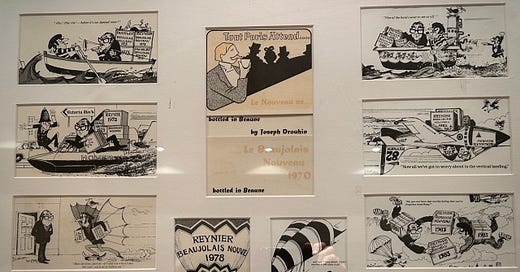Le Beaujolais Nouveau est de retour!
A look at the Beaujolais Nouveau craze of the ‘70s and ‘80s and for paid subscribers a recommendation to cheer up the dank days of November.
‘Le Beaujolais nouveau est arrivé!’ If that phrase means anything to you, you’re likely of a vintage that remembers pre-Clarkson Top Gear. Growing up in the 1980s, you couldn’t miss adverts in the colour supplements for the Beaujolais Run - an annual race to be the first to bring the new wine back to England. People would rush over to Burgundy in their Aston Martins and Jaguars, fill up with Beaujolais, and roar back home.
The idea for a race across France was cooked up by Clement Freud and wine merchant Joseph Berkmann in 1970. It really took off in 1974 when The Sunday Times offered a prize to the first person to bring a case of wine back to the newspaper’s offices following its release at midnight on the third Thursday in November.
The first winner was John Patterson who flew it back in an aeroplane and arrived in London at 2:30am, much to the consternation of all the proto-Clarksons, I imagine. In an amusing footnote Patterson was the entrepreneur behind Dateline, the first computer dating service, and would later go on to own Hambledon vineyard in Hampshire from 1985 to 19941. It was the start of increasingly elaborate ways to bring in the young wine. According to Ed Foster in Motorsport magazine:
“This glorious madness reached its zenith in the 1980s when the RAF touched down in Beaujeu with a Harrier Jump-Jet at midnight, picked up the wine and then landed 32 minutes later in London….”
Eventually the French authorities got tired of speeding Englishmen haring across France in the middle of the night and moved the release venue to Calais which rather took the fun out of the event.
Beaujolais is, mainly, a light red wine from the south of Burgundy made from the gamay grape. Producers in the region began promoting the release of the ‘nouveau’ wines in 1951. Many other regions also celebrate the release of the new wine like in the Heuriger of Vienna but only Beaujolais managed to turn it into a global event.

According to Mark Reynier, former owner of Bruichladdich distillery and now at Waterford in Ireland, the wine was first shipped to England in 1959 by Rene and Therese Rochone at Chez Solange, a fashionable restaurant in Cranbourn Street near Leicester Square. Reynier’s father was a wine shipper who was supplying the restaurant. Reynier told me in an email:
“When I joined the trade, a decade before you in 1980, J B Reynier were shipping four containers, it was a huge logistical affair to get the lorries in, usually around dawn, unloaded and redistributed to a manic posse of impatiently revving lorries, trucks, vans, cars that careered off like Italian Job Minis to all parts of the UK for boozy nouveau breakfasts and lunches”.
It was, in keeping with the wine, just good fun and no-one took it too seriously, it lightened up those dark and dreary pre-Christmas days when trade was flat and wine bars were new. And then the supermarkets got involved, and we knew then it was over. Nouveau died a death almost immediately - a bit like when Pimm’s was ‘democratised' - it lost its status, became too clichéd and mainstream. The quality, what there was, collapsed. From one year to the next - must have been about 1985 or 86 - it was dead as dodo.”
Nevertheless someone must have been buying it as Beaujolais Nouveau fever continued into the ‘90s though not among the smart set. At its peak in 1992 over half the production of the entire region went into these ephemeral wines.
The quality was usually nothing to write home about. Auberon Waugh described the annual event as…
Keep reading with a 7-day free trial
Subscribe to Drinking Culture to keep reading this post and get 7 days of free access to the full post archives.



